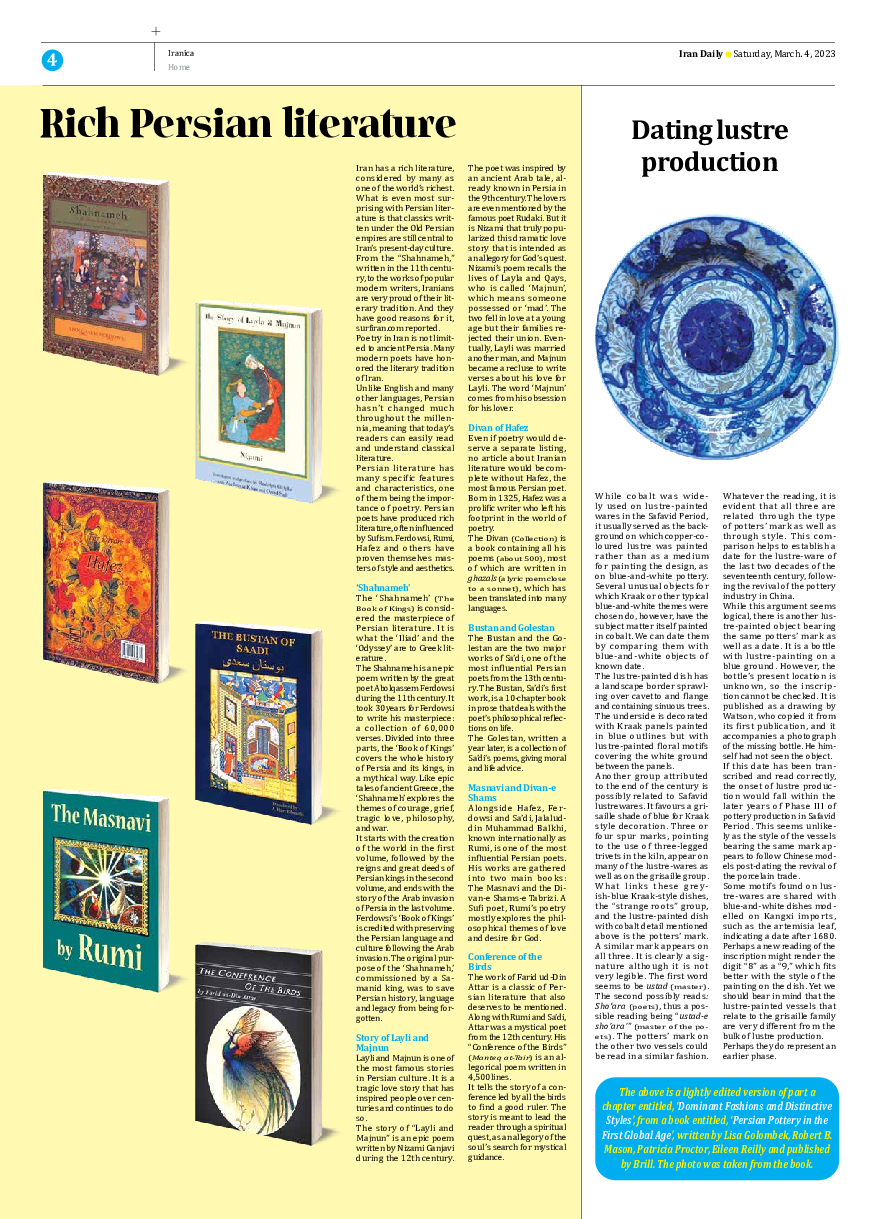
Rich Persian literature
Iran has a rich literature, considered by many as one of the world’s richest. What is even most surprising with Persian literature is that classics written under the Old Persian empires are still central to Iran’s present-day culture.
From the “Shahnameh,” written in the 11th century, to the works of popular modern writers, Iranians are very proud of their literary tradition. And they have good reasons for it, surfiran.com reported.
Poetry in Iran is not limited to ancient Persia. Many modern poets have honored the literary tradition of Iran.
Unlike English and many other languages, Persian hasn’t changed much throughout the millennia, meaning that today’s readers can easily read and understand classical literature.
Persian literature has many specific features and characteristics, one of them being the importance of poetry. Persian poets have produced rich literature, often influenced by Sufism. Ferdowsi, Rumi, Hafez and others have proven themselves masters of style and aesthetics.
‘Shahnameh’
The ‘Shahnameh’ (The Book of Kings) is considered the masterpiece of Persian literature. It is what the ‘Iliad’ and the ‘Odyssey’ are to Greek literature.
The Shahnameh is an epic poem written by the great poet Abolqassem Ferdowsi during the 11th century. It took 30 years for Ferdowsi to write his masterpiece: a collection of 60,000 verses. Divided into three parts, the ‘Book of Kings’ covers the whole history of Persia and its kings, in a mythical way. Like epic tales of ancient Greece, the ‘Shahnameh’ explores the themes of courage, grief, tragic love, philosophy, and war.
It starts with the creation of the world in the first volume, followed by the reigns and great deeds of Persian kings in the second volume, and ends with the story of the Arab invasion of Persia in the last volume.
Ferdowsi’s ‘Book of Kings’ is credited with preserving the Persian language and culture following the Arab invasion. The original purpose of the ‘Shahnameh,’ commissioned by a Samanid king, was to save Persian history, language and legacy from being forgotten.
Story of Layli and Majnun
Layli and Majnun is one of the most famous stories in Persian culture. It is a tragic love story that has inspired people over centuries and continues to do so.
The story of “Layli and Majnun” is an epic poem written by Nizami Ganjavi during the 12th century. The poet was inspired by an ancient Arab tale, already known in Persia in the 9th century. The lovers are even mentioned by the famous poet Rudaki. But it is Nizami that truly popularized this dramatic love story that is intended as an allegory for God’s quest.
Nizami’s poem recalls the lives of Layla and Qays, who is called ‘Majnun’, which means someone possessed or ‘mad’. The two fell in love at a young age but their families rejected their union. Eventually, Layli was married another man, and Majnun became a recluse to write verses about his love for Layli. The word ‘Majnun’ comes from his obsession for his lover.
Divan of Hafez
Even if poetry would deserve a separate listing, no article about Iranian literature would be complete without Hafez, the most famous Persian poet. Born in 1325, Hafez was a prolific writer who left his footprint in the world of poetry.
The Divan (Collection) is a book containing all his poems (about 500), most of which are written in ghazals (a lyric poem close to a sonnet), which has been translated into many languages.
Bustan and Golestan
The Bustan and the Golestan are the two major works of Sa’di, one of the most influential Persian poets from the 13th century. The Bustan, Sa’di’s first work, is a 10-chapter book in prose that deals with the poet’s philosophical reflections on life.
The Golestan, written a year later, is a collection of Sa’di’s poems, giving moral and life advice.
Masnavi and Divan-e Shams
Alongside Hafez, Ferdowsi and Sa’di, Jalaluddin Muhammad Balkhi, known internationally as Rumi, is one of the most influential Persian poets. His works are gathered into two main books: The Masnavi and the Divan-e Shams-e Tabrizi. A Sufi poet, Rumi’s poetry mostly explores the philosophical themes of love and desire for God.
Conference of the Birds
The work of Farid ud-Din Attar is a classic of Persian literature that also deserves to be mentioned. Along with Rumi and Sa’di, Attar was a mystical poet from the 12th century. His “Conference of the Birds” (Manteq at-Tair) is an allegorical poem written in 4,500 lines.
It tells the story of a conference led by all the birds to find a good ruler. The story is meant to lead the reader through a spiritual quest, as an allegory of the soul’s search for mystical guidance.







